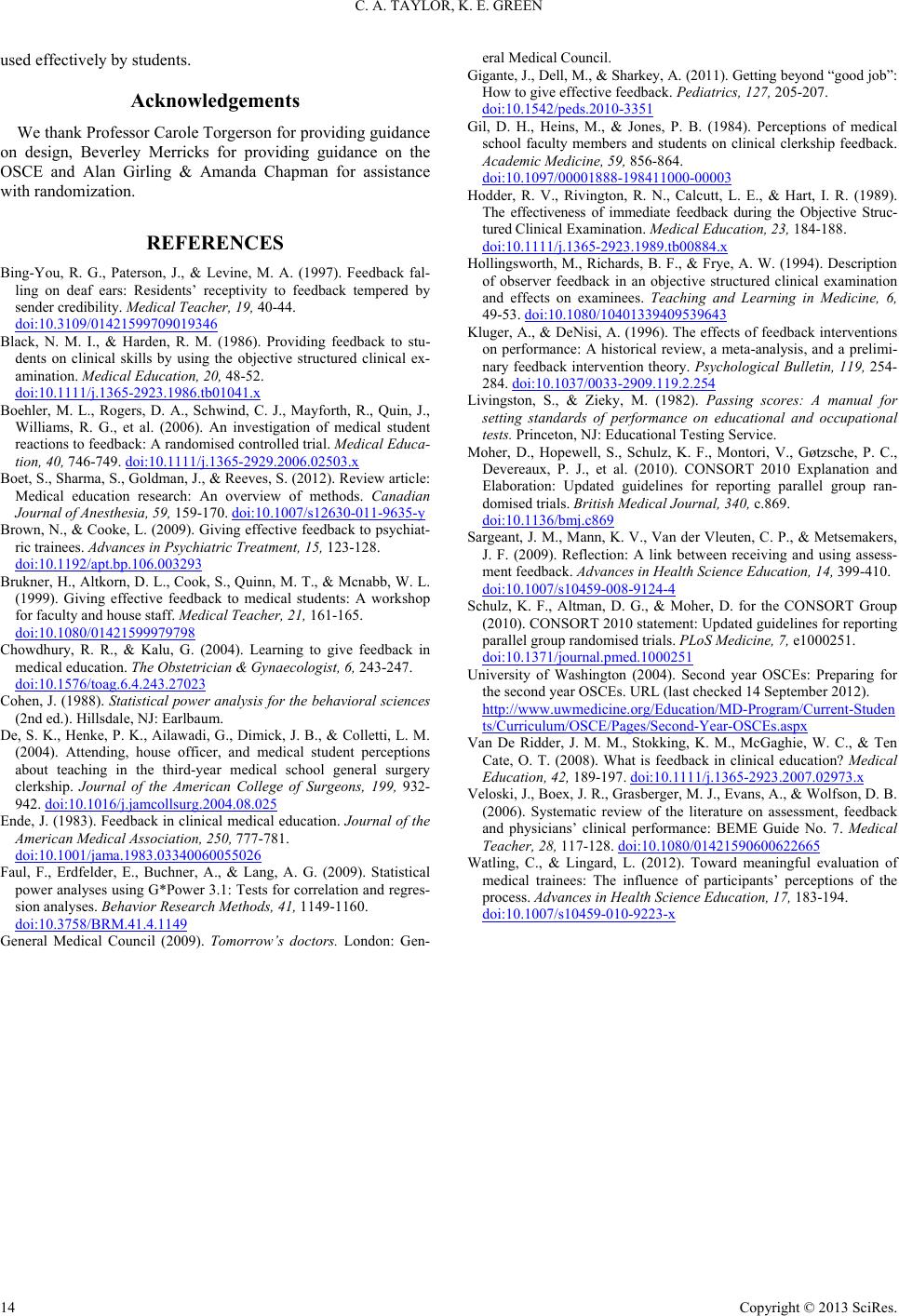
C. A. TAYLOR, K. E. GREEN
Copyright © 2013 SciRes.
14
used effectively by students.
Acknowledgements
We thank Professor Carole Torgerson for providing guidance
on design, Beverley Merricks for providing guidance on the
OSCE and Alan Girling & Amanda Chapman for assistance
with randomization.
REFERENCES
Bing-You, R. G., Paterson, J., & Levine, M. A. (1997). Feedback fal-
ling on deaf ears: Residents’ receptivity to feedback tempered by
sender credibility. Medical Teacher, 19, 40-44.
doi:10.3109/01421599709019346
Black, N. M. I., & Harden, R. M. (1986). Providing feedback to stu-
dents on clinical skills by using the objective structured clinical ex-
amination. Medical Education, 20, 48-52.
doi:10.1111/j.1365-2923.1986.tb01041.x
Boehler, M. L., Rogers, D. A., Schwind, C. J., Mayforth, R., Quin, J.,
Williams, R. G., et al. (2006). An investigation of medical student
reactions to feedback: A randomised controlled trial. Medical Educa-
tion, 40, 746-749. doi:10.1111/j.1365-2929.2006.02503.x
Boet, S., Sharma, S., Goldman, J., & Reeves, S. (2012). Review article:
Medical education research: An overview of methods. Canadian
Journal of Anesthesia, 59, 159-170. doi:10.1007/s12630-011-9635-y
Brown, N., & Cooke, L. (2009). Giving effective feedback to psychiat-
ric trainees. Advances in Psychiatric Treatment, 15, 123-128.
doi:10.1192/apt.bp.106.003293
Brukner, H., Altkorn, D. L., Cook, S., Quinn, M. T., & Mcnabb, W. L.
(1999). Giving effective feedback to medical students: A workshop
for faculty and house staff. Medic a l T e ac h e r , 21, 161-165.
doi:10.1080/01421599979798
Chowdhury, R. R., & Kalu, G. (2004). Learning to give feedback in
medical education. The Obstetrician & Gynaecologist, 6, 243-247.
doi:10.1576/toag.6.4.243.27023
Cohen, J. (1988). Statistical power analysis for the behavioral sciences
(2nd ed.). Hillsdale, NJ: Earlbaum.
De, S. K., Henke, P. K., Ailawadi, G., Dimick, J. B., & Colletti, L. M.
(2004). Attending, house officer, and medical student perceptions
about teaching in the third-year medical school general surgery
clerkship. Journal of the American College of Surgeons, 199, 932-
942. doi:10.1016/j.jamcollsurg.2004.08.025
Ende, J. (1983). Feedback in clinical medical education. Journal of the
American Medical Association, 250, 777-781.
doi:10.1001/jama.1983.03340060055026
Faul, F., Erdfelder, E., Buchner, A., & Lang, A. G. (2009). Statistical
power analyses using G*Power 3.1: Tests for correlation and regres-
sion analyses. Behavior Research Methods, 41, 1149-1160.
doi:10.3758/BRM.41.4.1149
General Medical Council (2009). Tomorrow’s doctors. London: Gen-
eral Medical Council.
Gigante, J., Dell, M., & Sharkey, A. (2011). Getting beyond “good job”:
How to give effective feedback. Pediatrics, 127, 205-207.
doi:10.1542/peds.2010-3351
Gil, D. H., Heins, M., & Jones, P. B. (1984). Perceptions of medical
school faculty members and students on clinical clerkship feedback.
Academic Medicine, 59, 856-864.
doi:10.1097/00001888-198411000-00003
Hodder, R. V., Rivington, R. N., Calcutt, L. E., & Hart, I. R. (1989).
The effectiveness of immediate feedback during the Objective Struc-
tured Clinical Examination. Medical Education, 23, 184-188.
doi:10.1111/j.1365-2923.1989.tb00884.x
Hollingsworth, M., Richards, B. F., & Frye, A. W. (1994). Description
of observer feedback in an objective structured clinical examination
and effects on examinees. Teaching and Learning in Medicine, 6,
49-53. doi:10.1080/10401339409539643
Kluger, A., & DeNisi, A. (1996). The effects of feedback interventions
on performance: A historical review, a meta-analysis, and a prelimi-
nary feedback intervention theory. Psychological Bulletin, 119, 254-
284. doi:10.1037/0033-2909.119.2.254
Livingston, S., & Zieky, M. (1982). Passing scores: A manual for
setting standards of performance on educational and occupational
tests. Princeton, NJ: Educational Testing Service.
Moher, D., Hopewell, S., Schulz, K. F., Montori, V., Gøtzsche, P. C.,
Devereaux, P. J., et al. (2010). CONSORT 2010 Explanation and
Elaboration: Updated guidelines for reporting parallel group ran-
domised trials. British Medical Journal, 34 0, c.869.
doi:10.1136/bmj.c869
Sargeant, J. M., Mann, K. V., Van der Vleuten, C. P., & Metsemakers,
J. F. (2009). Reflection: A link between receiving and using assess-
ment feedback. Advances in Health Science Education, 14 , 399-410.
doi:10.1007/s10459-008-9124-4
Schulz, K. F., Altman, D. G., & Moher, D. for the CONSORT Group
(2010). CONSORT 2010 statement: Updated guidelines for reporting
parallel group randomised trials. PLoS Medicine, 7, e1000251.
doi:10.1371/journal.pmed.1000251
University of Washington (2004). Second year OSCEs: Preparing for
the second year OSCEs. URL (last checked 14 September 2012).
http://www.uwmedicine.org/Education/MD-Program/Current-Studen
ts/Curriculum/OSCE/Pages/Second-Year-OSCEs.aspx
Van De Ridder, J. M. M., Stokking, K. M., McGaghie, W. C., & Ten
Cate, O. T. (2008). What is feedback in clinical education? Medical
Education, 42, 189-197. doi:10.1111/j.1365-2923.2007.02973.x
Veloski, J., Boex, J. R., Grasberger, M. J., Evans, A., & Wolfson, D. B.
(2006). Systematic review of the literature on assessment, feedback
and physicians’ clinical performance: BEME Guide No. 7. Medical
Teacher, 28, 117-128. doi:10.1080/01421590600622665
Watling, C., & Lingard, L. (2012). Toward meaningful evaluation of
medical trainees: The influence of participants’ perceptions of the
process. Advances in Health Science Educa ti on , 17, 183-194.
doi:10.1007/s10459-010-9223-x